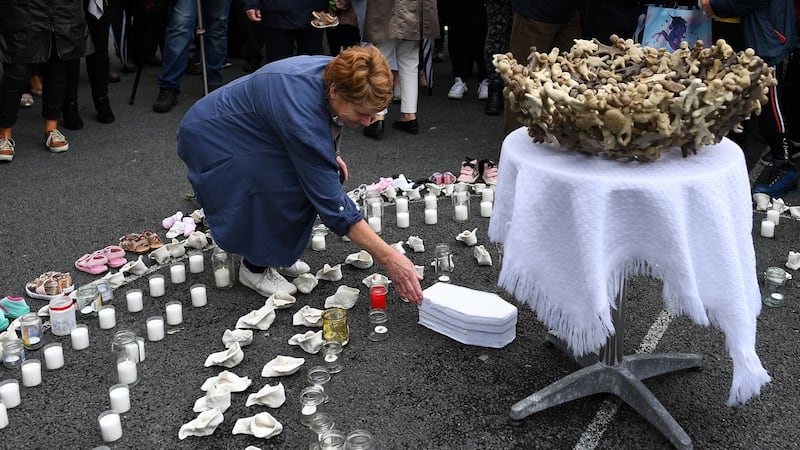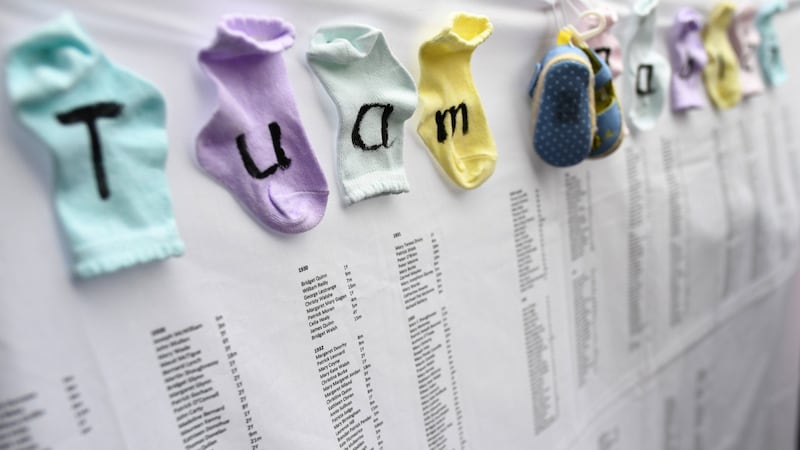The gathering set off from the Square in Tuam just before three o'clock on a slow walk up to the old home.
Teddy bears and cuddly toys had been tied to the gates and the posts along the road, up towards the small corner where the remains of 796 infants lie buried in a septic tank next to what is now a playground in the middle of a housing estate on the outskirts of town.
As a burial place, it defies the imagination.
A small shrine of babies’ shoes and ceramic boots had been arranged around the centre-circle of the tarmac basketball court.
Small cream coloured cards with the names of the babies and their ages printed in plain font were handed around.
The idea was as devastating as it was simple: to call their names aloud, on the site of the Mother and Baby home where they had died, in the same hour as Pope Francis was leading Mass at the Phoenix Park in Dublin.
Some voices faltered, others carried.
And at first the names came slowly and even hesitantly - ... “Gerard Cunningham ...11 months...Mary Cafferty... 2 months.... Mary P. Carroll 4 months...Mary Kate Connell, 3 years, 3 months, Anne Curley 3 weeks, George Coyne 2 years six months.”.
Eventually, someone said: “Just shout them.”
And then the overcast afternoon- one of those unalterable, drowsy west of Ireland Sundays - became charged with an unexpected and sudden voltage of energy and defiance.

Out of nothing, all the voices starting calling out the babies’ names together: the playground was filled with a blizzard of names and strengthening voices.
Just beyond the middle circle, where Catherine Corless, the Tuam woman whose burning curiosity and dogged research led to the discovery of the burial site was standing, someone was blowing soap bubbles into the air.
Nearby, a group stood together holding placards with the names of the 10 women who had died while under the care of the Bon Secours order. The realisation that this must have been the first time when all of the children’s names had been heard at this place, loud and clear, settled over the vigil.
It was very dignified and very sad.
Some of those in the crowd were born in the Home. Others came because they felt they had to be there.
“I think a rather strange analogy has taken place in my lifetime,” says John Rodgers, who was born in the home in 1947. “Here I am and I’m watching the Pope on TV. And he has arrived in Dublin there for a special day of world families together. And here we are, the same church and state. And 50 years ago they were separating families. They separated me from my mother. It is just hard to understand that.”
Tom Warde is 75. He spent the first five years of his life here. He has 15 grandchildren now: a lot of birthdays to remember. His recollection of the home is vague.
“The memories I have are of leaving it. In a green van. Everyone will tell you about the green van.”

Pat Duffy from Killimor spent his first six months here. His mother died when he was an infant and as his father was elderly even then, he was signed into the home at three months.
Both of his ears were left damaged from constant battering and pulling by the nuns in the home. He remembers the feel of a nappy left unchanged for days. He remembers the repercussions at dinner time for any high jinks at the table. “I was nervous all the time,” he says.
Ann O’Gorman came up on the bus from Limerick. She gave birth to a baby girl in Bessborough in Cork in 1971 and was sedated for three days afterwards. “When I woke they told me I’d an angel: that she was gone.”
Just last year, she obtained documents that convinced her that her child had been taken for adoption.
Her sister had gone to Knock to see Pope Francis. She shakes her head at the idea of it. “And I believe in God and in Our Lady and everything,” she says. “But I can’t. I had to turn my back.”
It was only a short ceremony but afterwards, people stood talking and visiting the shrine where the remains still lie. Nobody was in a rush to leave.
They are determined to see the babies buried properly. They are determined to have the rest of the area excavated.
Izzy Kamikaze has spent recent years studying the plans of the drainage and plumbing systems of the entire site in Tuam. “These vaulted systems lined in stone. So I discovered there was 11 of these cesspits on this site, not just one.”
Tom Warde knows he must have spent the first few years of his life sleeping alongside some of the children who never got to leave.
“We want them buried in that graveyard out there,” he says, firmly.
“Not here. They should never have knocked that building,” he says, glancing across as if the forbidding, hated old house was still standing. “I believe we were part owners of it. We were born and reared in it and many of us died in it.”










